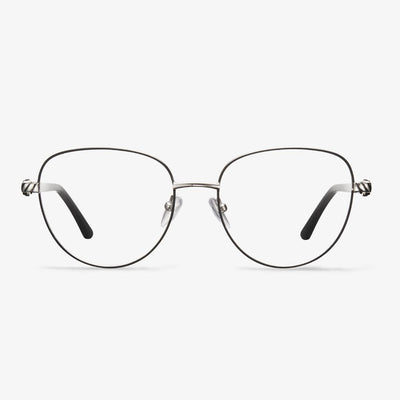Should face shape be considered when wearing rimless glasses?
In our life, we will see a lot of people who wear rimless glasses. Compared with full-frame glasses, there is no restriction on face shape and it suits most face shapes. Whether you have a square face, a long face, or a round face, wearing rimless glasses is trendy and beautiful, very popular among contemporary young businessmen and women. Rimless glasses are very easy to wear. No matter what shape your face is, it will feel stylish and beautiful. Rimless glasses are very simple on collocation dresses. And rimless glasses suit most face shapes, so they are suitable for many people.
Is there a standard for lens material selection?
No, again, according to your needs and budget. The materials of lens mainly include glass and resin, among which resin materials are divided into thermoplastic materials and thermosetting materials, respectively represented by PC and CR39. Different from the lens frame, the lens market choice is more uniform. And in recent years, resin lenses do better and better, most people choose thermosetting resin lenses.
Can you wear blue light glasses while driving?
The damage of blue light has a cumulative effect. The longer the exposure time is, the more serious the damage of retinal cells will be, which will eventually lead to irreversible damage of the structure and function of the retina. Once the retina has permanent damage, degeneration will directly affect the metabolism and function of photoreceptor cells, resulting in vision loss. It depends on the glasses you're wearing. The function of anti-blue light glasses depends on the material of the glasses. Some blue light glasses have a special anti-reflective coating, which can reduce glare. These glasses are definitely helpful when driving at night.
The inadequacies of bifocals
The field of vision is smaller than that of the single vision lens, especially for the close view. For example, reading and reading newspapers need to make it coordinated with the head movement, there are optical defects of image jump and image displacement. There is a boundary, and it is easy to be seen that wearing a bifocal lens exposes age. Bifocals clearly demarcate the near and far regions, affecting appearance and vision. And when far view and close view change, the objects will jump. Because most myopic patients have a lag in the adjustment response, wearing bifocal lenses not only does not delay the development of myopia but has side effects. Therefore, bifocals are not suitable for teenagers to control myopia, and only a few special patients need to wear bifocals.
Superior properties of titanium alloy
The specific strength (strength/density) of titanium alloy is far higher than other metal structural materials, which can produce high unit strength, good rigidity parts.The engine parts, frames, fasteners, and landing gear are all made of titanium.It can still maintain the demanded strength at medium temperature and can work for a long time at 450 ~ 500℃.
Types of Optical Frame Glasses
The full-frame glasses have good strength, suitable for athletes and children to wear because the lens is completely protected by the lens ring. They are suitable for a variety of refractive parameters of the lens. The upper part of the lens ring is made of metal or plastic materials. The lower half of the lens ring is made of a very fine nylon wire like the lower part of the lens ring. Rimless glasses are lighter than full-frame glasses. Rimless glasses can be divided into parts type and integral type. The part type consists of a nose bridge (together with the nose pad) and two temples. The combination glasses are divided into two parts. Usually, the front group is equipped with colored lenses, and the rear group is equipped with lenses for correcting refractive errors. The folding glasses can usually be folded at the bridge of the nose and the temple to reduce the space when stored or carried and are mostly used for making reading glasses.
What Are Progressive Lenses?
Progressive lenses also called multifocal lenses, have three prescriptions in one pair of glasses, which allows you to see near, middle-distance, and far objects without changing your glasses.
The traditional glasses have telltale lines in the lenses, while the progressive lenses are an update on bifocal and trifocal lenses. Progressive lenses have a seamless look. Sometimes, they are called no-line bifocals. The more accurate name is no-line trifocals.
Progressive lenses are typically designed for people over 40 years old who are both nearsighted and farsighted. With the progressive lenses, there is no need for you to change the nearsightedness eyeglasses and the farsightedness eyeglasses constantly.











































